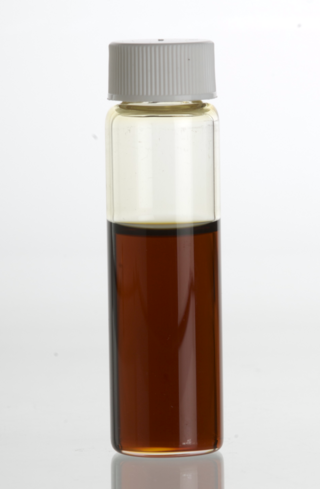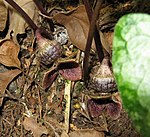
Flowering plants are plants that bear flowers and fruits, and form the clade Angiospermae, commonly called angiosperms. The term "angiosperm" is derived from the Greek words ἀγγεῖον /angeion and σπέρμα / sperma ('seed'), meaning those plants that produce their seeds enclosed within a fruit. They are by far the most diverse group of land plants with 64 orders, 416 families, approximately 13,000 known genera and 300,000 known species. Angiosperms were formerly called Magnoliophyta.
Wild ginger may refer to any of a variety of plants, often with a similar appearance, odour or taste to cultivated ginger. Species involved include:

Cornus florida, the flowering dogwood, is a species of flowering tree in the family Cornaceae native to eastern North America and northern Mexico. An endemic population once spanned from southernmost coastal Maine south to northern Florida and west to the Mississippi River. The tree is commonly planted as an ornamental in residential and public areas because of its showy bracts and interesting bark structure.

Wisteria is a genus of flowering plants in the legume family, Fabaceae (Leguminosae). The genus includes four species of woody twining vines that are native to China, Japan, Korea, Vietnam, southern Canada, the Eastern United States, and north of Iran. They were later introduced to France, Germany and various other countries in Europe. Some species are popular ornamental plants. The genus name is also used as the English name, and may then be spelt 'wistaria'. In some countries in Western and Central Europe, Wisteria is also known by a variant spelling of the genus in which species were formerly placed, Glycine. Examples include the French glycines, the German Glyzinie, and the Polish glicynia.

The Aristolochiaceae are a family, the birthwort family, of flowering plants with seven genera and about 400 known species belonging to the order Piperales. The type genus is Aristolochia L.

The Buxales are a small order of eudicot flowering plants, recognized by the APG IV system of 2016. The order includes the family Buxaceae; the families Didymelaceae and Haptanthaceae may also be recognized or may be included in the Buxaceae. Many members of the order are evergreen shrubs or trees, although some are herbaceous perennials. They have separate "male" (staminate) and "female" (carpellate) flowers, mostly on the same plant. Some species are of economic importance either for the wood they produce or as ornamental plants.

A cherry blossom, also known as Japanese cherry or sakura, is a flower of many trees of genus Prunus or Prunus subg. Cerasus. They are common species in East Asia, including China, Korea and especially in Japan. They generally refer to ornamental cherry trees, not to be confused with cherry trees that produce fruit for eating. It is considered the national flower of Japan.

Asarum is a genus of plants in the birthwort family Aristolochiaceae, commonly known as wild ginger.

Plant reproductive morphology is the study of the physical form and structure of those parts of plants directly or indirectly concerned with sexual reproduction.

Prunus serrulata or Japanese cherry is a species of cherry tree that grows naturally in Japan, China, and Korea, and it also refers to a cultivar produced from Prunus speciosa, a cherry tree endemic in Japan. Historically, the Japanese have developed many cultivars by selective breeding of cherry trees, which are produced by the complicated crossing of several wild species, and they are used for ornamental purposes all over the world. Of these, the cultivars produced by complex interspecific hybrids based on the Oshima cherry are also known as the Cerasus Sato-zakura Group.

Wisteria floribunda, common name Japanese wisteria, is a species of flowering plant in the family Fabaceae, native to Japan. Growing to 9 m (30 ft), Wisteria floribunda is a woody, deciduous twining climber. It was first brought from Japan to the United States in the 1830s. Since then, it has become one of the most highly romanticized flowering garden plants. It is also a common subject for bonsai, along with Wisteria sinensis.

Camellia japonica, known as common camellia, or Japanese camellia, is a species of Camellia, a flowering plant genus in the family Theaceae. There are thousands of cultivars of C. japonica in cultivation, with many colors and forms of flowers. In the U.S. it is sometimes called japonica. In the wild, it is found in mainland China, Taiwan, southern Korea and southwestern Japan. It grows in forests, at altitudes of around 300–1,100 metres (980–3,600 ft).

Asarum europaeum, commonly known as asarabacca, European wild ginger, hazelwort, and wild spikenard, is a species of flowering plant in the birthwort family Aristolochiaceae, native to large parts of temperate Europe, and also cultivated in gardens. It is a creeping evergreen perennial with glossy green, kidney shaped leaves and solitary dull purple flowers hidden by the leaves. Though its roots have a ginger aroma, it is not closely related to the true culinary ginger Zingiber officinale, which originates in tropical Asian rainforests. It is sometimes harvested for use as a spice or a flavoring. In former days, it was used in snuff and also medicinally as an emetic and cathartic.

A flower, sometimes known as a bloom or blossom, is the reproductive structure found in flowering plants. Flowers produce gametophytes, which in flowering plants consist of a few haploid cells which produce gametes. The "male" gametophyte, which produces non-motile sperm, is enclosed within pollen grains; the "female" gametophyte is contained within the ovule. When pollen from the anther of a flower is deposited on the stigma, this is called pollination. Some flowers may self-pollinate, producing seed using pollen from the same flower or a different flower of the same plant, but others have mechanisms to prevent self-pollination and rely on cross-pollination, when pollen is transferred from the anther of one flower to the stigma of another flower on a different individual of the same species.
Plant reproduction is the production of new offspring in plants, which can be accomplished by sexual or asexual reproduction. Sexual reproduction produces offspring by the fusion of gametes, resulting in offspring genetically different from either parent. Asexual reproduction produces new individuals without the fusion of gametes, resulting in clonal plants that are genetically identical to the parent plant and each other, unless mutations occur.

Asarum canadense, commonly known as Canada wild ginger, Canadian snakeroot, and broad-leaved asarabacca, is a herbaceous, perennial plant which forms dense colonies in the understory of deciduous forests throughout its native range in eastern North America, from the Great Plains east to the Atlantic Coast, and from southeastern Canada south to around the Fall Line in the southeastern United States.

Asarum caudatum is a plant native to rich moist forests of western North America. It has heart-shaped leaves and a three-lobed purplish flower.

Spikenard, also called nard, nardin, and muskroot, is a class of aromatic amber-colored essential oil derived from Nardostachys jatamansi, a flowering plant in the honeysuckle family which grows in the Himalayas of Nepal, China, and India. The oil has been used over centuries as a perfume, a traditional medicine, or in religious ceremonies across a wide territory from India to Europe. Historically, the name nard has also referred to essential oils derived from other species including the closely related valerian genus, as well as Spanish lavender; these cheaper, more common plants have been used in perfume-making, and sometimes to adulterate true spikenard.

Solidago ouachitensis is a North American species of flowering plants in the family Asteraceae known by the common name Ouachita Mountain goldenrod. It has a very limited range, found only in the Ouachita Mountains along the border between Arkansas and Oklahoma in the United States.

















